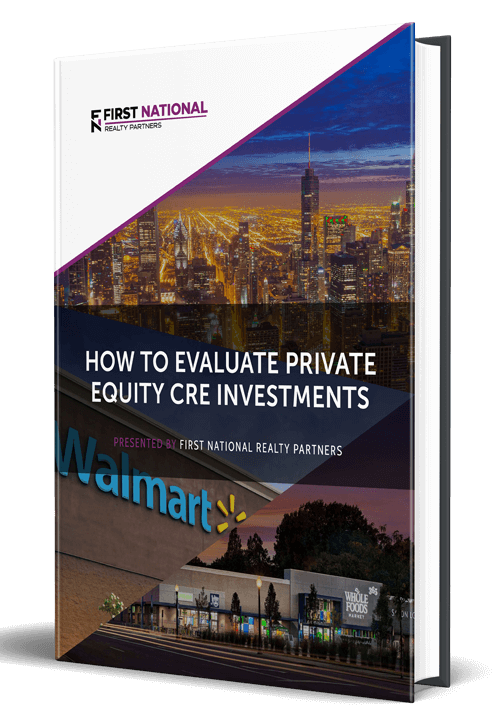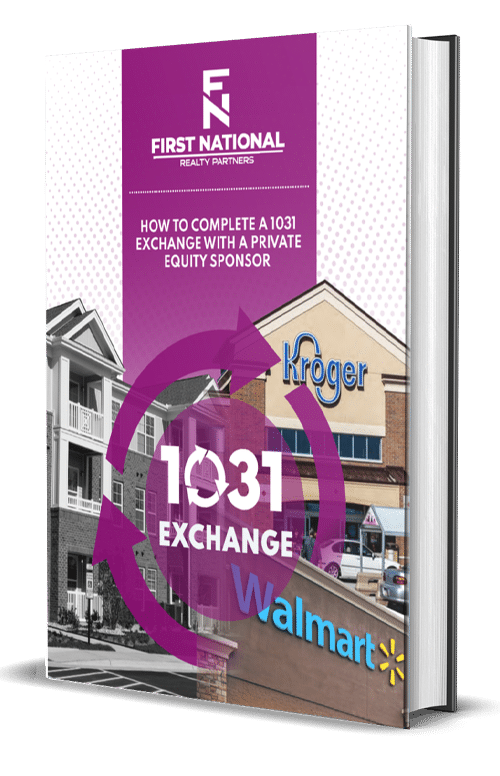As professional commercial real estate investors, we analyze and compare the cash flow for dozens of potential investment properties before making the decision to acquire one. But, this is easier said than done because all properties have slightly different sizes, locations, tenants, and conditions. As a result, it can be difficult to make a true “apples to apples” comparison between investment properties.
To overcome the challenge of comparing investment property opportunities, many investors (including FNRP) use a valuation metric known as the “capitalization rate,” or simply “cap rate.”
It may be tempting to ask, “what is a good cap rate for commercial real estate?” In this article, we explain why there isn’t a simple answer to this question, but that it depends on other factors, such as the perceived risk associated with acquiring the asset. We also define cap rates, discuss how to calculate cap rates, and discuss factors that drive cap rates in commercial real estate.
What is a Capitalization Rate?
Cap rate is a metric used in commercial real estate to estimate a property’s potential rate of return, assuming it is purchased with cash. Cap rate is expressed as a percentage and can vary widely depending on the real estate market, asset class, property type, and tenant base. In commercial real estate, most properties trade in a cap rate range of ~3% – 20%.
How To Calculate Cap Rate
For a commercial investment property, the cap rate is calculated by the net operating income (NOI) divided by the purchase price or the property value. The cap rate formula is written below:

To understand why the numbers in a cap rate calculation are used, and how they are derived, it can make sense to break them into their individual components.
Net operating income is calculated as the property’s annual gross income less its operating expenses, and the purchase price is the amount specified in the sales contract. If the purchase price value isn’t available, it could be substituted with an estimate of the property’s current market value or the valuation specified in an appraisal.
Why is a Good Cap Rate Important in Commercial Real Estate?
The result of the cap rate calculation is important in commercial real estate because it provides investors with a lot of information about the value of the property, the risk in acquiring it, and the property’s potential return. For example, a higher cap rate indicates a higher potential return, but it also indicates higher levels of risk, which means that the price an investor may be willing to pay is lower.
Example
To illustrate this point, assume that an investor was considering the purchase of the following two properties:
Property 1: $100,000 NOI / $1,000,000 Purchase Price = 10% Cap Rate.
Property 2: $500,000 NOI / $6,250,000 Purchase Price = 8% Cap Rate
When comparing these two potential purchases, it is safe to assume that Property 1 carries more risk because it has a higher cap rate. Conversely, this means that Property 2 has less risk, which makes it more expensive per dollar of NOI produced. In other words, the relative safety of Property 2 means that an investor must pay more for a lower return. This doesn’t necessarily make Property 2 an inferior option, but it is important for investors to understand why the cap rate is lower.
Factors that Drive Cap Rates in Commercial Real Estate
The cap rate of a commercial property is driven by a number of factors, all of which are related to the perceived risk in the property and the stability of the income stream produced. These factors include:
1. Lease Duration
Rental properties with long term leases tend to command lower cap rates (higher prices) than those with short term leases. This is because a short term lease represents some level of risk that a tenant will not renew their lease and/or the renewal rental rate may be lower than the current one. In either case, the property’s income stream could be reduced, which leads to lower values.
2. Tenant Credit
Commercial properties with tenants who are financially strong (ex: dCVS, Dollar General, Walgreens) tend to command lower cap rates (higher prices) than those with tenants whose financial condition is weak or unknown. This is because a tenant with a weak or unknown financial condition increases the risk of lease default, which would reduce the property’s net operating income and value.
3. Property Location
Properties with high traffic locations tend to command lower cap rates (higher prices) than those with low traffic locations. This is because stronger locations tend to attract stronger tenants, which reduces tenant default risk and increases the stability of the property’s income stream. For example, a well located property in New York or San Francisco would likely have a higher sale price (lower cap rate) than a similar property in Tulsa or Omaha.
4. The Property’s Replacement Cost
A property’s replacement cost is the expense that would be incurred to rebuild the property from scratch and lease it to full occupancy. Properties that are selling at or below replacement cost tend to command lower cap rates (higher prices) than those selling above replacement costs because there is less risk that market conditions could compel a new investor to build a comparable property from scratch and lease it for similar rates.
5. Property Type
Each commercial property type has its own idiosyncratic risks, which means that they tend to command different cap rates. For example, multifamily apartment buildings tend to command lower cap rates because they are considered less risky than an office building, while grocery-anchored shopping center cap rates tend to fluctuate.
6. Property Class
Commercial properties are graded according to their “class,” which is indicative of the property’s quality, location, finishes, and risk. Each commercial real estate property class is identified by a letter (A-D), each of which come with their own cap rate.
Class A Properties
Class A properties are the newest and have the best location and most luxurious finishes. They likely also have the strongest tenants on long term leases. For this reason, Class A properties are considered to be the least risky, which means they sell for the lowest cap rates (highest prices).
Depending on the property type and location, the cap rate for Class A properties ranges from ~4.00% – 8.00%.
Class B Properties
Class B properties may have a slightly inferior location when compared with Class A, and their finishes may be slightly dated. Class B properties have solid tenants with some near term lease expirations and carry slightly more risk than Class A properties.
Depending on the property type and location, the cap rate for Class B properties ranges from 6.00% – 9.00%.
Class C Properties
Class C properties may have a secondary location and their finishes are likely dated and in need of updates. They have solid tenants with some near term lease expirations and some existing vacancy. Class C properties carry slightly more risk than Class B properties.
Depending on the property type and location, the cap rate for Class C properties ranges from 7.00% – 10.00%.
Class D Properties
Class D properties are the most risky type. They often involve properties that are in poor condition and/or some sort of financial distress. As a result, there is a wide range of observable cap rates for Class D properties.
Depending on the property type and location, the cap rate for Class D properties is north of 10%.
7. Expected Returns
An investor’s expected return is a function of their perceived risk in purchasing a property. If the property is perceived to have higher risk, an investor will demand a higher return, which means they will pay a lower price. If the property is perceived to have lower risk, the investor may require a lower return on investment, which means they will pay a higher price.
In addition, return expectations can change relative to investment alternatives. For example, the interest rate on the 10-Year Treasury Bond is commonly referred to as the “risk free rate,” meaning that this is as close as an investor can get to earning a risk free return on their investment.
Cap rates often change relative to the risk free rate. For example, if an investor can earn 5% on a 10-Year Treasury Bond, they would certainly demand to earn a higher rate for the additional risk associated with purchasing a commercial real estate asset.
Is There Such Thing as a Good Cap Rate in Commercial Real Estate?
Unfortunately, there isn’t a simple answer to the question, “What is a good cap rate?” The truth is that it depends. For commercial real estate—or any real estate, for that matter—there is no cap rate that is better than another because cap rates are all relative to the perceived risk associated with acquiring the investment property.
Whether a cap rate is “good” is influenced by an individual’s investment strategy and risk tolerance, the asset class (office, multifamily, industrial, retail), and the expected return.
For example, if one investor has a 10% annual return requirement, they would likely not be happy with an 8% cap rate. But another investor with a 6% annual return requirement would likely be just fine with an 8% cap rate.
As a broad generalization, average cap rates for commercial real estate assets tend to range from ~4% for the highest quality, best located properties to 12%+ for properties that may have some physical, financial, or operational issues.
Interested In Learning More?
First National Realty Partners is one of the country’s leading private equity commercial real estate investment firms. With an intentional focus on finding world-class, multi-tenanted assets well below intrinsic value, we seek to create superior long-term, risk-adjusted returns for our investors while creating strong economic assets for the communities we invest in.
When evaluating our own deals, we invest a significant amount of time and resources in analyzing a property’s cap rate relative to other options. We view this as integral to our pre-purchase due diligence process and a factor in our success. If you would like to learn more about our investment opportunities, contact us at (800) 605-4966 or info@fnrealtypartners.com for more information.






